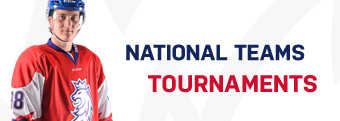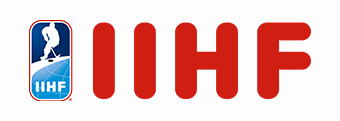History
“We the undersigned, submit the statutes of the Czech Ice Hockey Association, with respectful request, to be taken in consideration and return the approval as soon as possible to the hands of the preparative committee, Mr. E. Procházka, director of the Central commercial reporting in Prague.” An application with this text was written and submitted by enthusiastic sport promoter Emil Procházka on 11th November 1908. Eight days later, the statutes were confirmed by a state official named Zukal. On 19th November 1908, the Czech Ice Hockey Association was officially acknowledged. The initial general assembly was held on 11th December 1908 with members of 11 clubs being present in Prague restaurant Platýz.
In January 1909, Czech players took part in an international tournament in Chamonix. Seven players – Gruss, Vindyš, Malý, Hammer, J. Fleischmann, Jarkovský and Palouš – were later nicknamed “The Musketeers with sticks”. The team wore jerseys of Slavia, shorts for horse riding and lost every game at the tournament. However they caught the attention of the international and national press.
Right after their return from Chamonix, the first championship of Bohemia in so called “Canadian hockey” took place. In 1910, the first European championship was held. The Czechs participated the year after in Berlin, and after beating Germany 13:0 and Switzerland 4:1, they won the tournament on their first attempt. The Czechs hosted the Championship in 1912 in Prague, but after German appeal against the state of the playing field, all the results were nullified.
The Czechs won bronze medals at the World Championships in 1933 and 1938, which were originally part of the Winter Olympic games, but became an annual event starting in 1930. In 1922, 1925, 1929 and 1933, the Czechs were European champions. In 1921, 1926, 1936, 1938 and 1939 they finished second, and in 1923, 1932, 1934 and 1935 they took bronze medals.
The first golden generations and lost years
When the World Championship in London was about to start on March 13, 1950, the organizers were missing one team. It was the defending champion Czechoslovak team. Two Czechoslovak radio reporters were allegedly denied visas, but it was only a false pretense used by the communist Czechoslovak government.
This was the beginning of the end of the best Czechoslovak team up until that point. In 1947, they won their first gold medals at the World Championship in Prague. In 1948, the team didn’t lose to Canada for the first time in history (0:0 draw) and was close to repeating the success from the previous year, but came up just short in the end.
In 1948, six national team players, five of them world champions, died during an air disaster over the The Channel. Nevertheless, the Czechoslovak team managed to win their second title at the World Championship in Stockholm the next year. Upon their arrival to Prague, crowds of frenetic fans welcomed them back home. It was meant to be the last happy return for a long time. The communists took over the country and tough times began even for the hockey stars.
15 months later, eleven hockey players were arrested. They went through harsh interrogations in a kangaroo court, and in the end they were sentenced to a combined total of 77 years and 4 months in jail for sedition. Goaltender Bohumil Modrý got 15 years, Augustin Bubník 14, Stanislav Konopásek 12, Václav Rožiňák and Vladimír Korbanov 10 years, Josef Jirka 6 and ten more players from 8 months to 3 years: Mojmír Ujčík, Zlatko Červený, Jiří Marcelis, Přemysl Hainý, Antonín Španninger and Josef Štock.
Some of those unjustly sentenced got out of jail after five years, the best goalie of that time Modrý was released with seriously damaged health. It took a long time until Czechoslovak hockey coped with these heavy wounds. There were also more issues that appeared in connection with the regime such as KÁDROVÁNÍ or countless times of reorganization. However, the success was not that far on some occasions. In 1961, the national team defeated the Soviets in Geneva and became European Champions again after 12 years. They only lost the World Championship title to Canada on goal difference. For that triumph, the Czechoslovak hockey had to wait 11 more years until 1972.
The IIHF put their 1969 World Championship in Prague to celebrate 60 years of hockey in Czechoslovakia, however the Communist regime didn’t have much of an interest in people gathering in a joyful atmosphere. They were afraid of possible protests and riots, so Czechoslovakia was forced to give up the Championship to Stockholm.
That was where the team of an occupied country faced the USSR selection for the first time. The players on the ice were fighting also for Prague. Some of the players displayed their opinions by covering a five-point star above lions on their jerseys with black stick tape. “You send tanks on us, we score goals on you!” was the motto after two unforgettable evenings. The Czechoslovaks won 2-0 and 4-3. To beat Soviets back-to-back was something nobody else has ever done before. They finished third in the tournament, but they were welcomed as champions back home. World Championship titles came later in the 70s, in 1972, 1976 and 1977 respectively. Another big triumph of Czechoslovak hockey was at a home tournament in 1985.
Golden age of hockey. What next?
In the late 80s, the map of Europe changed significantly as well as the geography of world ice hockey. After the fall of communist regimes, the iron curtain between West and East was no more. The Soviet Union collapsed and new states rose from its ashes. In 1993, Czechoslovakia split into two sovereign countries. Their team for the World Juniors was the last one with both Czechs and Slovaks in it. In the 1994 Olympic games in Lillehammer, they faced each other for the very first time.
After those crucial political changes, even players from post-communist countries could leave and go to play in the NHL as well as in top competitions in Western Europe and Scandinavia. Hockey globalized. The new world order also meant a new balance of power. The gaps among elite hockey teams closed down.
The Czech hockey took some time to recover after losing many players who went abroad. But then came an era to remember. A gold medal form the World Championship in Vienna was just the beginning. The generation of players around Robert Reichel, Pavel Patera, David Výborný and Martin Ručinský won gold medals a total of five times! But the most cherished triumph came at the Olympic games in 1998 in Nagano, Japan.
According to some, the Czechs had approximately the same chances as the popular Jamaican bobsleigh team. But the Czech team beat all the favorites – USA, Canada and Russia – on their way to the first ever Olympic gold medal. And it simply had to be Petr Svoboda to score the game winning goal in the final against Russia. The same Svoboda who defected when he was 18 years old, and got his first and only chance to represent the Czech Republic in 1998.
It was Dominik Hašek though, who stole the show. The winner of the Vezina trophy for the Best NHL Goalie, and also two-time winner of the Hart trophy for the Most Valuable Player, was a key part of the huge success in Nagano. He was the heart of the team and his performance was decisive. “Hašek for President” chanted the Czech fans back home. Crowds of tens of thousands people went into the streets to watch the final game and celebrate the biggest success of the national team.
The triumph at the Olympic Games awoke national pride and poured self-confidence into the veins of Czech players. Nagano was the highlight and symbol for the golden era of Czech ice hockey. From 1999 to 2001, the Czech Republic won the World Championship three times in a row. Only Canada and USSR were able to achieve the “three-peat” before. Thw Czechs went on to win the gold medals in 2005 and 2010 while the U20 team won the World Championship back-to-back in 2000 and 2001. The country also brought back bronze medals from the Olympic tournament in Torino and silver medals from the Worlds in Riga just a couple months later.
Winning medals became much more difficult as the top teams got more even. From 1920 (the first World Championship) until 1991, a total of 57 sets of medals were divided at the Olympic games and World championships among just six nations – Canada, USSR, Czechoslovakia, Sweden, Great Britain and the USA. But just in the following 17 years, the same number of states grabbed some medals. In 1995, Finland joined the chosen ones while Slovakia won their first gold medal in 2002.



